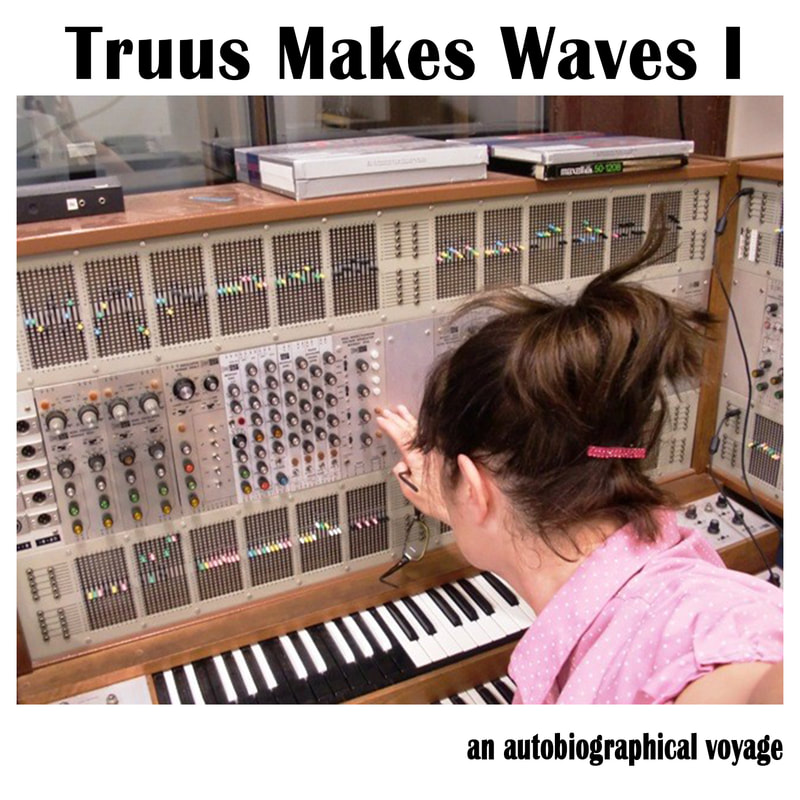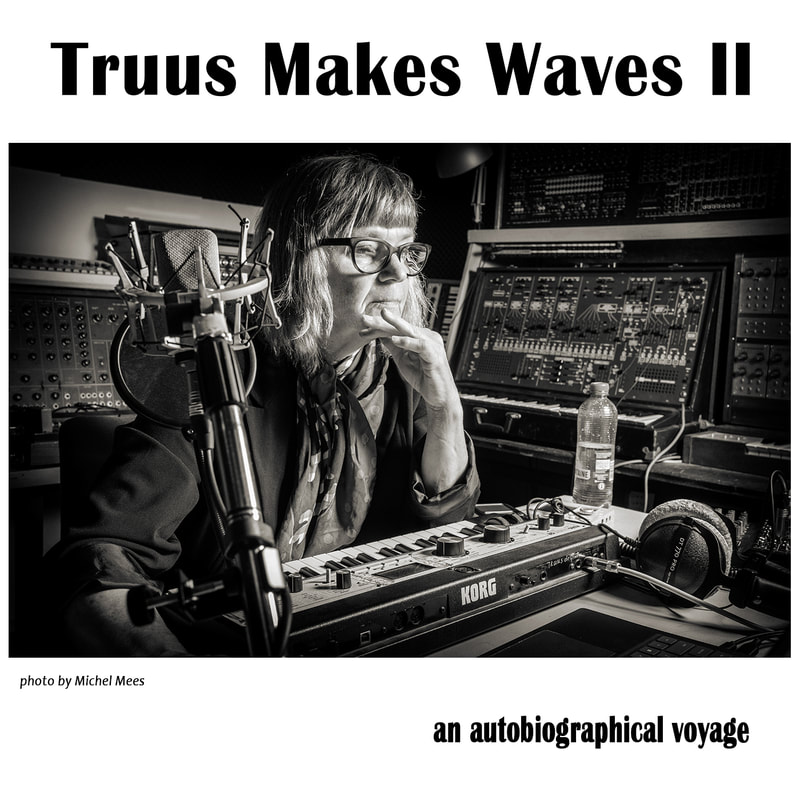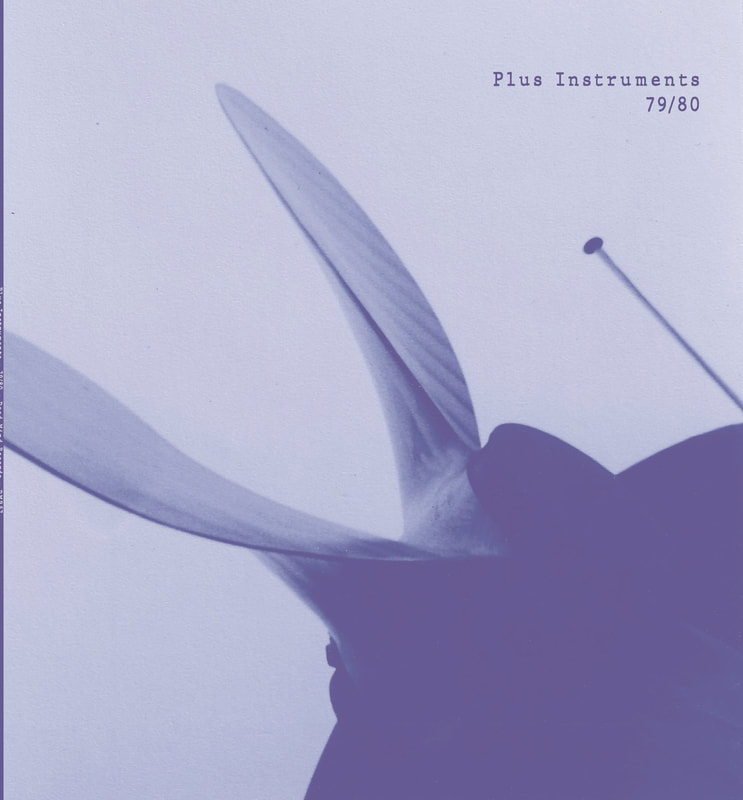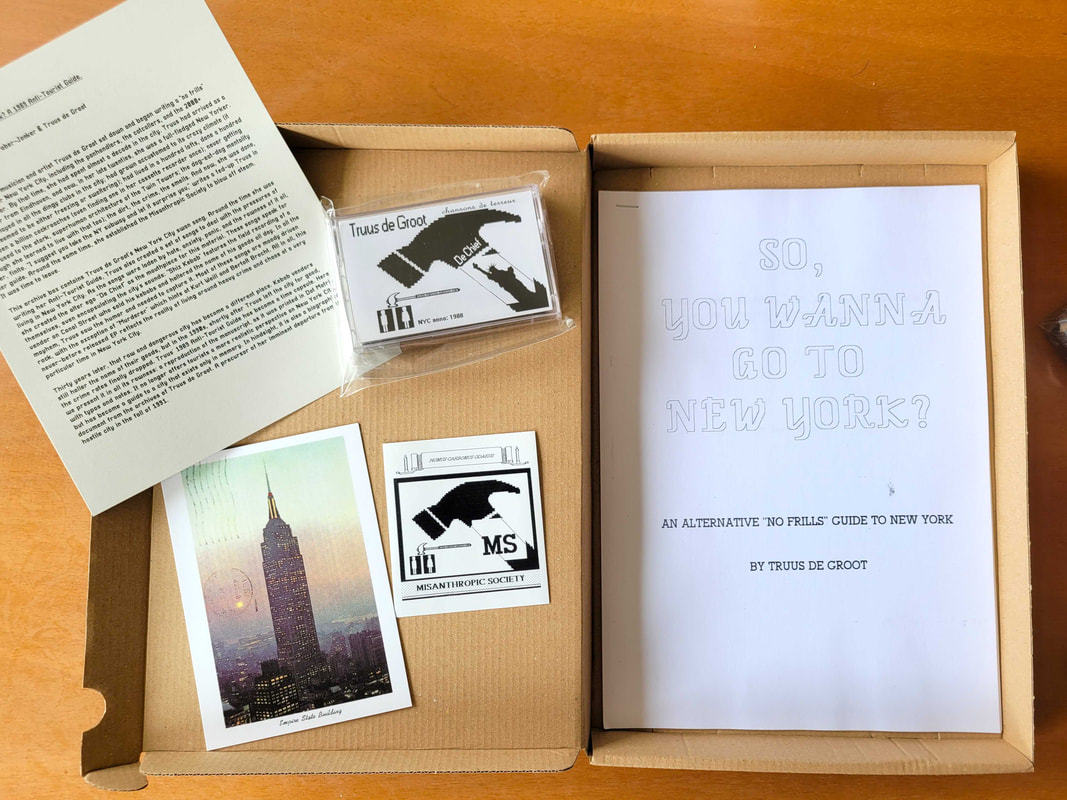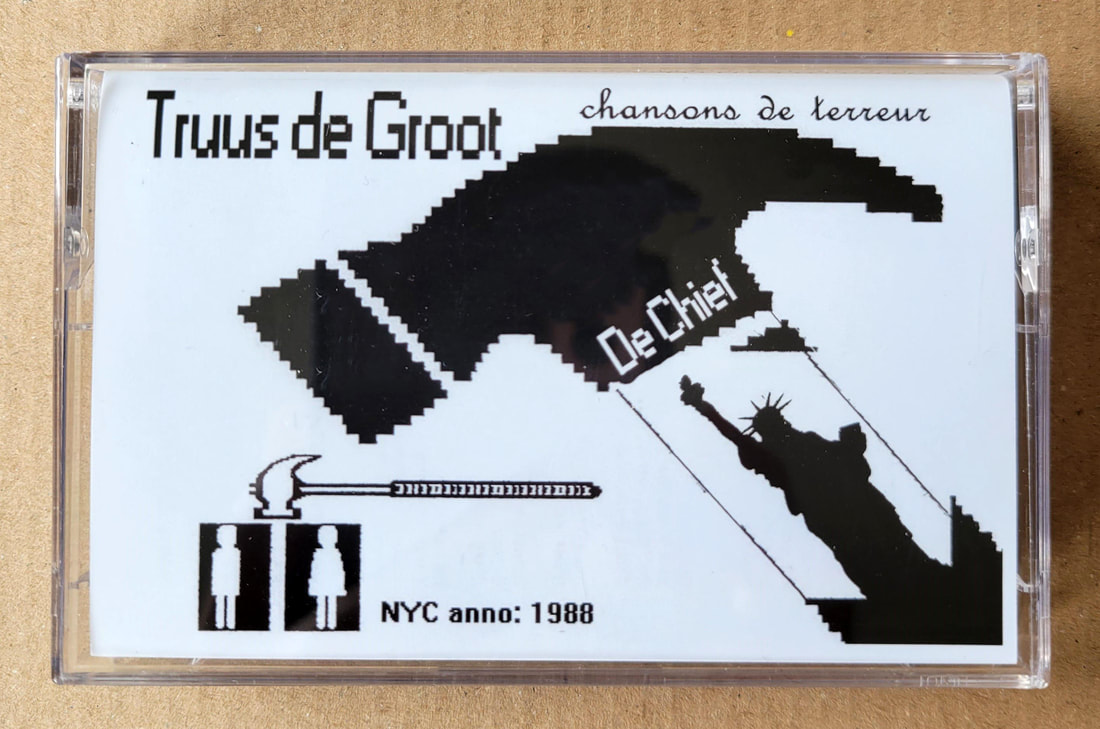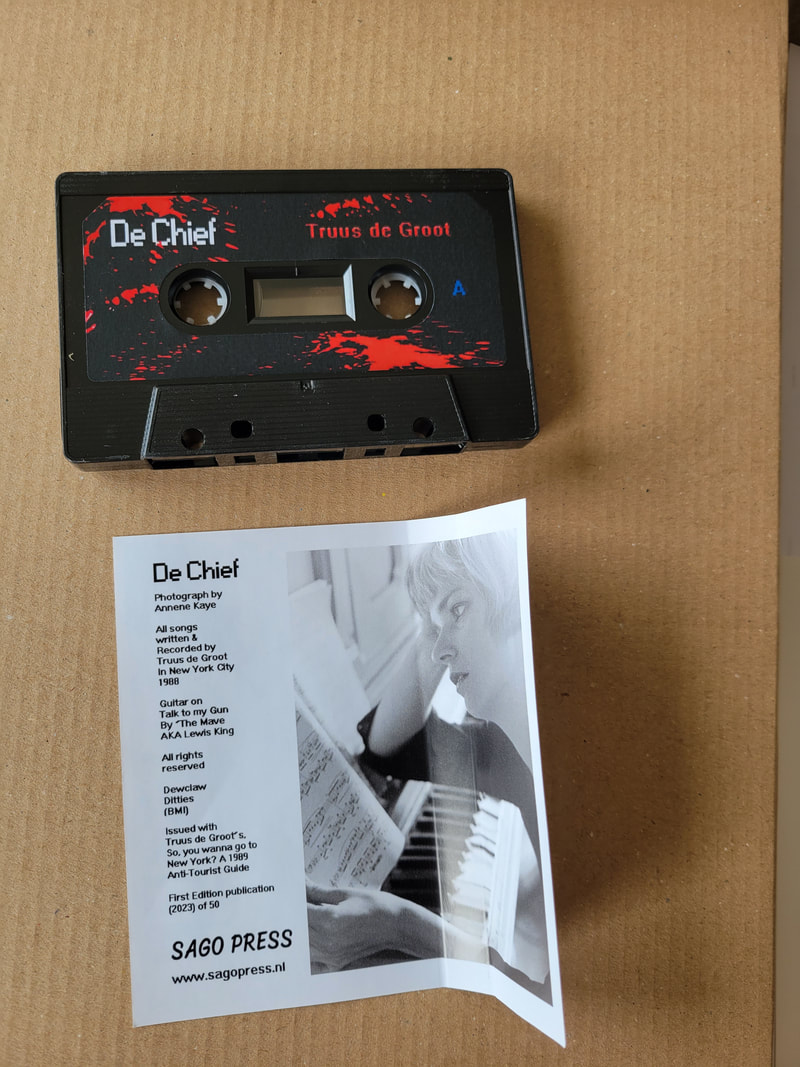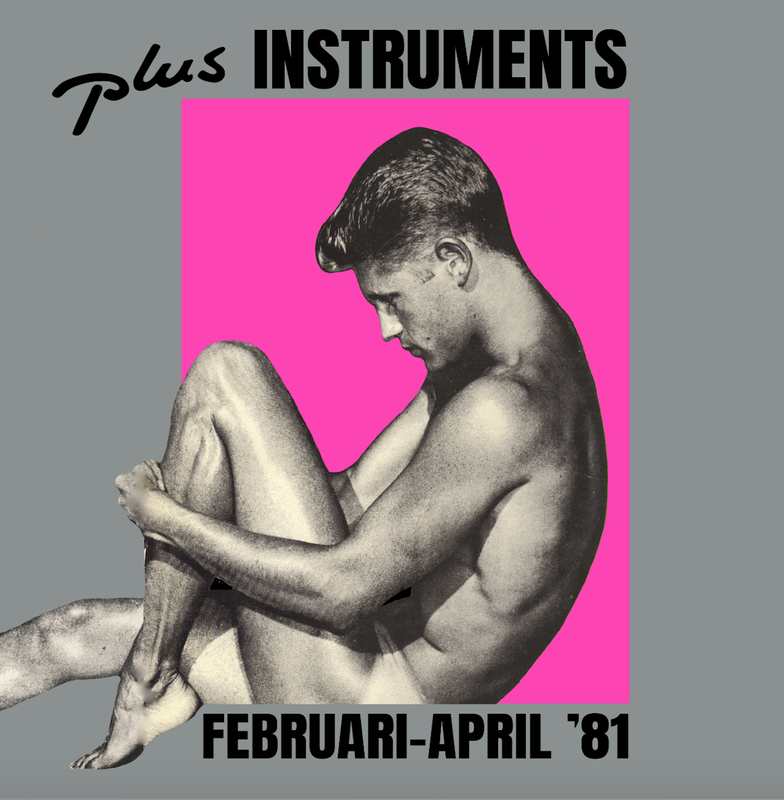Truus' Autobiographical works out now on Bandcamp!
Veneman en de Groot
You probably thought you've seen everything that is Truus..hmm? Well now she is taking a dive into the Dutch language Schlager genre "Smartlappen" . A match made in her hometown of Eindhoven with the genre bending Woody Veneman, another real trailblazer (in a later generation) and legend in Eindhoven. They got together and decided Smartlappen needed them as they needed Smartlappen like you never heard them before! Look for an album out this year..they hope... For now Listen to a track HERE
Coming soon in 2024. A brand new Collaborative album by Cosmo Vitelli and Truus de Groot.
Stay tuned!
Stay tuned!
Out Now! Streaming on Bandcamp
What is a dive bar? First of all, if it’s really a dive bar, it doesn’t consider itself one. Its regulars would never call their home-away-from-home a dive. Nor would its proprietors, who would be insulted if you applied the term to their place of business. But aren’t these bars low-rent? Most of the time. Seedy? Some of the time. Dangerous? Not if you know the ropes. Rule #1: Order a beer, or a shot, or a beer and a shot. A dive bar is not a cocktail bar. Rule #2: Don’t chat up the regulars. Speak when spoken to, otherwise mind your own business. A dive bar is not a singles bar. Rule #3: Keep your mitts off the jukebox, which is strictly for regulars. And for crissakes, no dancing! This ain’t no disco. Instead, plug in your Ear Pods and listen to Truus de Groot’s “Music For Dive Bars.” She’s been there. She knows. Her soundscapes create a dive bar of the mind where time stops, dreams start, and nobody knows your name.
Cocktail Historian
Beachbum "Jeff" Berry
What is a dive bar? First of all, if it’s really a dive bar, it doesn’t consider itself one. Its regulars would never call their home-away-from-home a dive. Nor would its proprietors, who would be insulted if you applied the term to their place of business. But aren’t these bars low-rent? Most of the time. Seedy? Some of the time. Dangerous? Not if you know the ropes. Rule #1: Order a beer, or a shot, or a beer and a shot. A dive bar is not a cocktail bar. Rule #2: Don’t chat up the regulars. Speak when spoken to, otherwise mind your own business. A dive bar is not a singles bar. Rule #3: Keep your mitts off the jukebox, which is strictly for regulars. And for crissakes, no dancing! This ain’t no disco. Instead, plug in your Ear Pods and listen to Truus de Groot’s “Music For Dive Bars.” She’s been there. She knows. Her soundscapes create a dive bar of the mind where time stops, dreams start, and nobody knows your name.
Cocktail Historian
Beachbum "Jeff" Berry
New Vinyl release on Dead Mind Records - August 2023
Special Purple Colored edition available HERE
DMR57 Plus Instruments – 79/80 (Vinyl LP)
While she was still a member of Nasmak, Truus de Groot started Plus Instruments in 1978, with herself as the sole member. When the project evolved, she found a wide range of rotating collaborators like Michel Waisvisz, Lee Ranaldo or James Sclavunos. Plus Instruments was about freedom and the live performances were largely improvised. The sound minimal but captivating. The music always came from within, but De Groot was also triggered by bands like Red Crayola, Suicide, DAF, Wire, Per Ubu, Devo and the No Wave scene in NY. She was always experimenting with primitive multi-track recording and whatever crappy gadgets she could find. Always looking for a gritty, dirty sound and bizarre overtones.
At a young age she traveled to New York and began to immerse herself in the nightlife of the city that never sleeps. Here she found true creativity, passion and expression. The club scene was alive but highly competitive, so this fearless Dutch girl would just knock on promoter’s doors to get gigs booked at places like CBGB’s, Peppermint Lounge, Underground and the Pyramid. De Groot eventually settled in the United States and never stopped experimenting with sound. In recent years she reinvented Plus Instruments and led the group into new territory.
The recordings for this LP were made by De Groot at home and the music is experimental and industrial, it sounds nothing like some of the later material. 7 tracks are taken from the elusive and impossible to find self-released debut cassette as ‘Truss Plus Instruments’ which was sparingly distributed through the legendary Alien Brains fanzine. The other 7 are from the same period (1979-1980) and were selected from the vast archive of De Groot. This selection serves as a long overdue testament of the formative phase of a true female pioneer of electronic music.
200 copies on black vinyl with insert. 75 copies on purple vinyl with a signed and numbered print, an envelope with 4 small prints and a cassette with 2 archival live performances from the same period. A Truus de Groot solo performance at Van Abbe Museum, Eindhoven (1980) and a performance on dual Crackle synths with Michel Waisvisz and original Plus Instruments member Bregt Camphuijzen (on bass) at the Notre Dame Hall, London (1979).
Special Purple Colored edition available HERE
DMR57 Plus Instruments – 79/80 (Vinyl LP)
While she was still a member of Nasmak, Truus de Groot started Plus Instruments in 1978, with herself as the sole member. When the project evolved, she found a wide range of rotating collaborators like Michel Waisvisz, Lee Ranaldo or James Sclavunos. Plus Instruments was about freedom and the live performances were largely improvised. The sound minimal but captivating. The music always came from within, but De Groot was also triggered by bands like Red Crayola, Suicide, DAF, Wire, Per Ubu, Devo and the No Wave scene in NY. She was always experimenting with primitive multi-track recording and whatever crappy gadgets she could find. Always looking for a gritty, dirty sound and bizarre overtones.
At a young age she traveled to New York and began to immerse herself in the nightlife of the city that never sleeps. Here she found true creativity, passion and expression. The club scene was alive but highly competitive, so this fearless Dutch girl would just knock on promoter’s doors to get gigs booked at places like CBGB’s, Peppermint Lounge, Underground and the Pyramid. De Groot eventually settled in the United States and never stopped experimenting with sound. In recent years she reinvented Plus Instruments and led the group into new territory.
The recordings for this LP were made by De Groot at home and the music is experimental and industrial, it sounds nothing like some of the later material. 7 tracks are taken from the elusive and impossible to find self-released debut cassette as ‘Truss Plus Instruments’ which was sparingly distributed through the legendary Alien Brains fanzine. The other 7 are from the same period (1979-1980) and were selected from the vast archive of De Groot. This selection serves as a long overdue testament of the formative phase of a true female pioneer of electronic music.
200 copies on black vinyl with insert. 75 copies on purple vinyl with a signed and numbered print, an envelope with 4 small prints and a cassette with 2 archival live performances from the same period. A Truus de Groot solo performance at Van Abbe Museum, Eindhoven (1980) and a performance on dual Crackle synths with Michel Waisvisz and original Plus Instruments member Bregt Camphuijzen (on bass) at the Notre Dame Hall, London (1979).
a treasure trove of goodies on the special Purple edition of 75!!
|
Available HERE
|
Truus de Groot - So, You Wanna Go to New York? A 1989 Anti-Tourist Guide, on Sago Press!
Sunday, May 7th. 2 pm at HOK Gallery in Den Haag - with Truus and a live performance
Introduction by Leonor Faber-Jonker & Truus de Groot
One day in 1989, musician and artist Truus de Groot sat down and began writing a “no frills” tourist guide for New York City, including the panhandlers, the cat callers, and the 2000+ murders a year. By that time, she had spent almost a decade in the city. Truus had arrived as a young visitor from Eindhoven, and now, in her late twenties, she was a full-fledged New Yorker. She had played in all the dingy clubs in the city; had grown accustomed to its crazy climate (it always seemed to be either freezing or sweltering); had lived in a hundred lofts,done a hundred jobs, seen a billion cockroaches (even finding one in her cassette recorder once); never getting quite used to the stark, superhuman architecture of the Twin Towers;the dog-eat-dog mentality (though she learned to live with that too); the dirt, the crime, the smells. And now, she was done, over, finito. “I suggest you take the NY subway and let it surprise you,” writes a fed-up Truus in her guide. Around the same time, she established the Misanthropic Society to blow off steam. It was time to leave.This archive box contains Truus’ New York City swan song. Around the time she was writing her Anti-Tourist Guide, Truus also created a set of songs to deal with the pressures of living
in New York City. As the songs were laden by hate, anxiety, panic, and the rawness of it all,she created the alter ego “De Chief” as the mouthpiece for this material. These songs speak for themselves, even encapsulating the city’s sounds: “Shiz Kebab” features the field recording of a vendor on Canal Street who sold his kebabs and hollered the name of his
goods all day. In all the mayhem, Truus saw the humor and needed to capture it. Most of these songs are moody driven rock, with the exception of “Murderer” which hints at Kurt Weill and Bertolt Brecht. All in all, this never-before released EP reflects the reality of living around heavy crime and chaos at a very particular time in New York City.Thirty years later, that raw and dangerous city has become a different place. Kebab vendors still holler the name of their goods, but in the 1990s, shortly after Truus left the city for good, the crime rates finally dropped. Truus’ 1989 Anti-Tourist Guide has become a time capsule. Here, we present it in all its rawness: a reproduction of the manuscript, as it was printed in Dot Matrix with typos and notes. It no longer offers tourists a more realistic perspective on New York City, but has become a guide to a city that exists only in memory. In hindsight, it is also a biographical document from the archives of Truus de Groot. A precursor of her imminent departure from that hostile city in the fall of 1991.
Sunday, May 7th. 2 pm at HOK Gallery in Den Haag - with Truus and a live performance
Introduction by Leonor Faber-Jonker & Truus de Groot
One day in 1989, musician and artist Truus de Groot sat down and began writing a “no frills” tourist guide for New York City, including the panhandlers, the cat callers, and the 2000+ murders a year. By that time, she had spent almost a decade in the city. Truus had arrived as a young visitor from Eindhoven, and now, in her late twenties, she was a full-fledged New Yorker. She had played in all the dingy clubs in the city; had grown accustomed to its crazy climate (it always seemed to be either freezing or sweltering); had lived in a hundred lofts,done a hundred jobs, seen a billion cockroaches (even finding one in her cassette recorder once); never getting quite used to the stark, superhuman architecture of the Twin Towers;the dog-eat-dog mentality (though she learned to live with that too); the dirt, the crime, the smells. And now, she was done, over, finito. “I suggest you take the NY subway and let it surprise you,” writes a fed-up Truus in her guide. Around the same time, she established the Misanthropic Society to blow off steam. It was time to leave.This archive box contains Truus’ New York City swan song. Around the time she was writing her Anti-Tourist Guide, Truus also created a set of songs to deal with the pressures of living
in New York City. As the songs were laden by hate, anxiety, panic, and the rawness of it all,she created the alter ego “De Chief” as the mouthpiece for this material. These songs speak for themselves, even encapsulating the city’s sounds: “Shiz Kebab” features the field recording of a vendor on Canal Street who sold his kebabs and hollered the name of his
goods all day. In all the mayhem, Truus saw the humor and needed to capture it. Most of these songs are moody driven rock, with the exception of “Murderer” which hints at Kurt Weill and Bertolt Brecht. All in all, this never-before released EP reflects the reality of living around heavy crime and chaos at a very particular time in New York City.Thirty years later, that raw and dangerous city has become a different place. Kebab vendors still holler the name of their goods, but in the 1990s, shortly after Truus left the city for good, the crime rates finally dropped. Truus’ 1989 Anti-Tourist Guide has become a time capsule. Here, we present it in all its rawness: a reproduction of the manuscript, as it was printed in Dot Matrix with typos and notes. It no longer offers tourists a more realistic perspective on New York City, but has become a guide to a city that exists only in memory. In hindsight, it is also a biographical document from the archives of Truus de Groot. A precursor of her imminent departure from that hostile city in the fall of 1991.
GRIT. Truus de Groot in New York City Ltd Edition Book
|
GRIT. Truus de Groot in New York City is a photo book with previously unpublished photographs by musician, crackle box player, and experimental electronic pioneer Truus de Groot (a.o. Nasmak, Plus Instruments), made between 1981 and 1989 in her hometown New York City.
For USA shipping, Purchase here EU and World Wide contact SAGO PRESS |
* 44 glorious pages, incl. 32 never before published photographs and a full-quote interview with Truus de Groot about her life in NYC. Photo pages printed on Biotop; text Riso printed on RecyStar; poster & wrapper Riso printed on Muncken. Includes a reproduction of a NYC Plus Instruments poster. Includes a wrapper, Riso printed in Burgundy. Pattern from Truus' collection of vintage wrapping papers. Packed in a brown paper bag for added grit. Editorial design by Lula Valletta, printing & binding by Stencilwerck, The Hague. Regular Edition: $28. Special edition: $45 (sold out) (only 25 copies!) with signed & numbered photo print of Truus' favorite neon sign by night (you find a daytime shot in the book) + Riso printed wrapper in Faux CMYK:
November 2022 - Truus will have a Photo and Mixed Media solo exhibit at S/ash Gallery in Rotterdam (part of WORM) as well as a book release with SAGO Press. The book "GRIT. Truus de Groot in New York City" is SAGO's first Ltd edition publication and focuses on her photography as a fresh immigrant in New York City in the early 80's. Opening and Book launch on November 3rd. The opening will be followed by a Live Performance of Plus Instruments performing with the original early 80's backing tracks. Feat. Mathijs Burgler (Rats on Rafts) on drums & surprise guests. Truus will also have a residency at WORM Nov 9 through 16, host a radio show on Nov. 13th and a Film evening on November 16. She will screen her Super 8 film "Gallivanting" from the 80's with an original sound score created with music from that period dug out from her vast archives and re-edited, as well as a feature film, the action packed French Connection who's gritty NYC scenery stuck in her mind as a young teen. More info here
New vinyl releases
|
Reissue! Plus Instruments "Februari - April '81" re-issue on Vinyl - Ltd Edition of 400 on Domani Sounds. Official release on Bandcamp only, May 6th , 2022
|


